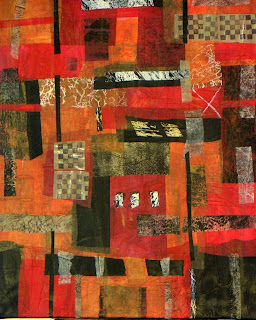Paintings and collages containing a variety of materials, including acrylic and watercolor paints, inks, prints, metal leaf, graphite and many types of paper--painted, printed, stamped and found.
My Blog List
Thursday, August 6, 2009
small collage "Garden Gate"
 Here is a smaller mixed-media collage -- 10" x 14". The photo
Here is a smaller mixed-media collage -- 10" x 14". The photoisn't the best, but I am pleased with the colors, shapes, composition, and use of texture. It is called "Garden Gate". (This collage now has a new home -- my sister, Andrea, liked it so much, she wanted to frame and hang it -- so off it went.)
decorated collage paper
more collage paper
printed collage paper
textured and stamped paper
Here is an example of textured and stamped paper that I have prepared for use in a collage. The top part is copper acrylic. The white dots will be stained with a color wash either before or after using them in a collage piece.
of textured and stamped paper that I have prepared for use in a collage. The top part is copper acrylic. The white dots will be stained with a color wash either before or after using them in a collage piece.
The textured, copper part was based on ideas from Carrie Burns Brown's DVD on making collages.
 of textured and stamped paper that I have prepared for use in a collage. The top part is copper acrylic. The white dots will be stained with a color wash either before or after using them in a collage piece.
of textured and stamped paper that I have prepared for use in a collage. The top part is copper acrylic. The white dots will be stained with a color wash either before or after using them in a collage piece.The textured, copper part was based on ideas from Carrie Burns Brown's DVD on making collages.
Our Dog Shauna
Wednesday, July 29, 2009
The Malibu Arts Festival
Anson and I have returned from our weekend in the LA area. Even though we were working, it was wonderful to enjoy beautiful weather and to view the spectacular ocean scenery. The Malibu Arts Festival was the first of these outdoor shows that I have ever done. I must say that all of my "booth neighbors" were pleasant, friendly and very talented. Many of those who stopped by our booth had positive comments on my collages that were so good to hear. Although there were many exhibitors with crafts, clothing, flowers and plants, there were fine artists represented as well in the painting, jewelry and sculpture categories.
Since several visitors inquired about the process of creating the collages, I will attempt to briefly summarize my procedure here. First, I stain, print and texturize many sheets of paper. (I use artists' tissue as well as mulberry, rice and other types of papers.) Then, I spread white gesso over a previously-primed canvas. For these particular collages I used 20" x 16" gallery-wrapped canvas. I textured the gesso with various palette knives and other instruments. When totally dry (at least 24 hours), I did an acrylic underpainting. I used either reds, blues or yellows as dominant colors. When dry, I started layering the painted papers which I had torn into strips. I started with the dark colors, using acrylic gloss medium and a brayer to adhere and seal the papers to the canvas. I added layers of textured papers along with more paint, inks and graphite in order to adjust the design and color. Usually, but not always, some of the underpainting shows through. I always let the wortk rest and then revisit to make more design and color adjustments. Finally, when everything is completely dry, I coat the work with a mixture of acrylic matte medium, water and a small amount of acrylic iridescent gold paint. (This levels everything out and gives a consistent finish.) I then cover the sides of the canvas with black gesso. So, that's about it. I'd be glad to answer any questions. Here are photos of the collages that were in the booth:
Since several visitors inquired about the process of creating the collages, I will attempt to briefly summarize my procedure here. First, I stain, print and texturize many sheets of paper. (I use artists' tissue as well as mulberry, rice and other types of papers.) Then, I spread white gesso over a previously-primed canvas. For these particular collages I used 20" x 16" gallery-wrapped canvas. I textured the gesso with various palette knives and other instruments. When totally dry (at least 24 hours), I did an acrylic underpainting. I used either reds, blues or yellows as dominant colors. When dry, I started layering the painted papers which I had torn into strips. I started with the dark colors, using acrylic gloss medium and a brayer to adhere and seal the papers to the canvas. I added layers of textured papers along with more paint, inks and graphite in order to adjust the design and color. Usually, but not always, some of the underpainting shows through. I always let the wortk rest and then revisit to make more design and color adjustments. Finally, when everything is completely dry, I coat the work with a mixture of acrylic matte medium, water and a small amount of acrylic iridescent gold paint. (This levels everything out and gives a consistent finish.) I then cover the sides of the canvas with black gesso. So, that's about it. I'd be glad to answer any questions. Here are photos of the collages that were in the booth:
Subscribe to:
Comments (Atom)























